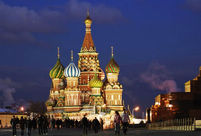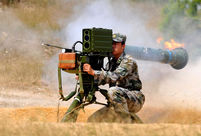 Shocking moments when PLA's weapons open fire
Shocking moments when PLA's weapons open fire Famous Lanzhou beef noodles
Famous Lanzhou beef noodles Armed Police hold anti-terrorism drill in SE China's Xiamen
Armed Police hold anti-terrorism drill in SE China's Xiamen Harbin Int'l Ice and Snow Festival opens
Harbin Int'l Ice and Snow Festival opens 'Jin' named the word of the year by cross-strait netizens
'Jin' named the word of the year by cross-strait netizens Chinese scientific expedition goes to build new Antarctica station
Chinese scientific expedition goes to build new Antarctica station
 Chinese naval escort fleet conducts replenishment in Indian Ocean
Chinese naval escort fleet conducts replenishment in Indian Ocean 17th joint patrol of Mekong River to start
17th joint patrol of Mekong River to start China's moon rover, lander photograph each other
China's moon rover, lander photograph each otherShanghai ranks 48th among the 74 Chinese cities that adopted a new national air quality monitoring system last year, with the city’s annual PM2.5 density nearly double the national standard, according to a survey released yesterday.
Beijing came 13th in the list of cities with the worst air.
Shanghai’s annual average PM2.5 density was 60.7 micrograms per square meter last year, compared to the national standard of 35, environmental organization Greenpeace reported.
PM2.5 refers to airborne particles smaller than 2.5 micrometers in diameter that are the cause of urban smog and hazardous to health.
Greenpeace said that, in December, Shanghai’s PM2.5 density peaked at 421 micrograms per square meter, five times the daily standard of 75.
The Greenpeace report was based on data from China’s Environmental Protection Ministry website as well as environmental protection bureaus in the 74 cities.
The Yangtze River Delta region has seen increasingly severe air pollution in recent years that has affected the air quality in Shanghai.
Ten cities among 13 monitoring data in Shanghai’s neighboring province to the north, Jiangsu, recorded double the national annual standard for PM2.5, while nearly all the cities in Zhejiang Province, to Shanghai’s south, exceeded the standard.
In December, when the PM2.5 reading was at its peak in Shanghai, it was four times the standard in Zhejiang’s capital of Hangzhou and Jiangsu’s Nanjing, according to the Greenpeace.
“Some 20 percent of the PM2.5 pollution in Shanghai is from other provinces,” said Zhang Quan, Shanghai Environmental Protection Bureau director.
Vehicle and factory emissions accounted for 50 percent of the city’s pollution, followed by dust from construction sites (10.5 percent), power stations (7.3 percent) and straw burning (10 percent).
“The Chinese government must take emergency measures to curb nationwide air pollution,” Greenpeace said.
Some 92 percent of Chinese cities failed to reach the national standard in 2013, with 32 of them double the national standard while the top 10 were three times the standard.
North Chinese cities, especially those in Hebei Province, suffered the most serious pollution. Seven of the top 10 most polluted cities are in Hebei, led by Xingtai and Shijiazhuang. Both are important industrial cities.
Xingtai’s annual PM2.5 density reached 155.2 micrograms per square meter.
The air in China’s central and west cities, such as Xi’an in Shaanxi Province, Zhenzhou in Henan and Wuhan in Hebei, was also highly polluted last year, Greenpeace said.
China is to spend 5 billion yuan (US$818 million) to curb air pollution in north China and aims to slash PM2.5 density by 25 percent in the region within five years.
The fund, mainly to reward effective measures taken by regional governments, will be used to improve the air in Beijing and Tianjin, Inner Mongolia Autonomous Region and Hebei, Shanxi and Shandong provinces, according to the Ministry of Finance.
Hebei will be one of the campaign’s major targets.
Haikou in Hainan Island had the best air quality among the 74 cities, with an annual PM2.5 density of 25.6, followed by Lhasa in Tibet and Xiamen in southeast Fujian Province.
 In photos: Ten 'tuhao' devices in 2013
In photos: Ten 'tuhao' devices in 2013 College students saved from an ice hole by brave citizens
College students saved from an ice hole by brave citizens Gallery: Top 10 box office hits in 2013
Gallery: Top 10 box office hits in 2013 Beautiful churches around the world
Beautiful churches around the world Yang Mi, Hawick Lau hold wedding in Bali
Yang Mi, Hawick Lau hold wedding in Bali 'Phubbing' people seen everywhere
'Phubbing' people seen everywhere World's biggest snack shop in China
World's biggest snack shop in China Shocking moments when PLA's weapons open fire
Shocking moments when PLA's weapons open fire World's fastest train CRH380A assembled in E China
World's fastest train CRH380A assembled in E China Top 10 box office hits in 2013
Top 10 box office hits in 2013 In photos: Ten 'tuhao' devices in 2013
In photos: Ten 'tuhao' devices in 2013 Real estate tycoon measures PM2.5
Real estate tycoon measures PM2.5  'I am on a journey to lose weight'
'I am on a journey to lose weight' 'Cute' artifacts exhibited in Nanjing Museum
'Cute' artifacts exhibited in Nanjing Museum Advanced Chinese weapons that stepped into spotlight in 2013
Advanced Chinese weapons that stepped into spotlight in 2013Day|Week|Month